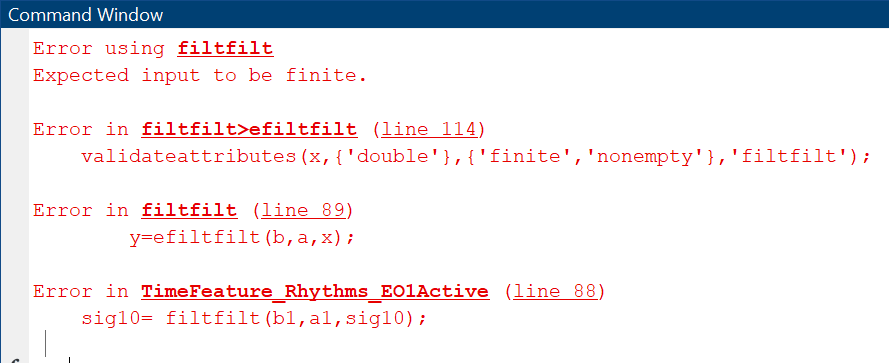%% Feature Extraction from EEG Rhythm in Time Domain, EO1, Active
clc
clear
close all
%% Load EO1, Active
load P01EO1
load P03EO1
load P05EO1
load P08EO1
load P09EO1
load P10EO1
load P11EO1
load P17EO1
load P18EO1
load P19EO1
load P21EO1
load P24EO1
load P25EO1
load P27EO1
%%
fs=256; % Sampling frequency(Hz)
Nf=36; %number of feautures
Nch= size(P01EO1,2); % number of columns(channels)
TfeaturesR_P01EO1= zeros(Nf,Nch);
TfeaturesR_P03EO1= zeros(Nf,Nch);
TfeaturesR_P05EO1= zeros(Nf,Nch);
TfeaturesR_P08EO1= zeros(Nf,Nch);
TfeaturesR_P09EO1= zeros(Nf,Nch);
TfeaturesR_P10EO1= zeros(Nf,Nch);
TfeaturesR_P11EO1= zeros(Nf,Nch);
TfeaturesR_P17EO1= zeros(Nf,Nch);
TfeaturesR_P18EO1= zeros(Nf,Nch);
TfeaturesR_P19EO1= zeros(Nf,Nch);
TfeaturesR_P21EO1= zeros(Nf,Nch);
TfeaturesR_P27EO1= zeros(Nf,Nch);
TfeaturesR_P25EO1= zeros(Nf,Nch);
TfeaturesR_P27EO1= zeros(Nf,Nch);
%% Step1: Denoising (50Hz)
% Design stop filter
fl= 49.9;
fh= 50.1;
order= 3;
wn= [fl fh]/ (fs/2);
type= ‘stop’;
[b1,a1]= butter(order,wn,type);
% Set up a for loop
for i=1:Nch
sig1= P01EO1(:,i);
sig2= P03EO1(:,i);
sig3= P05EO1(:,i);
sig4= P08EO1(:,i);
sig5= P09EO1(:,i);
sig6= P10EO1(:,i);
sig7= P11EO1(:,i);
sig8= P17EO1(:,i);
sig9= P18EO1(:,i);
sig10= P19EO1(:,i);
sig11= P21EO1(:,i);
sig12= P24EO1(:,i);
sig13= P25EO1(:,i);
sig14= P27EO1(:,i);
% Apply notch (stop) filter
sig1= filtfilt(b1,a1,sig1);
sig2= filtfilt(b1,a1,sig2);
sig3= filtfilt(b1,a1,sig3);
sig4= filtfilt(b1,a1,sig4);
sig5= filtfilt(b1,a1,sig5);
sig6= filtfilt(b1,a1,sig6);
sig7= filtfilt(b1,a1,sig7);
sig8= filtfilt(b1,a1,sig8);
sig9= filtfilt(b1,a1,sig9);
sig10= filtfilt(b1,a1,sig10);
sig11= filtfilt(b1,a1,sig11);
sig12= filtfilt(b1,a1,sig12);
sig13= filtfilt(b1,a1,sig13);
sig14= filtfilt(b1,a1,sig14);
%% Frequency Bands
% delta= 1-4 Hz,
% theta= 4-8 Hz,
% alpha= 8-12 Hz,
% beta= 12-20 Hz,
% low gamma= 20-25 Hz,
% gamma= 25-40 Hz
band= [1,4,8,12,20,25;
4,8,12,20,25,40];
%% Step2: Extract EEG Rhythms in Time Domain
for j=1:size(band,2); %first column:delta
% Design bandpass filter
wn= band(:,j)/ (fs/2);
[b2,a2]= butter(3,wn,‘bandpass’);
% Apply designed bandpass filter
sig_1= filtfilt(b2,a2,sig1);
sig_2= filtfilt(b2,a2,sig2);
sig_3= filtfilt(b2,a2,sig3);
sig_4= filtfilt(b2,a2,sig4);
sig_5= filtfilt(b2,a2,sig5);
sig_6= filtfilt(b2,a2,sig6);
sig_7= filtfilt(b2,a2,sig7);
sig_8= filtfilt(b2,a2,sig8);
sig_9= filtfilt(b2,a2,sig9);
sig_10= filtfilt(b2,a2,sig10);
sig_11= filtfilt(b2,a2,sig11);
sig_12= filtfilt(b2,a2,sig12);
sig_13= filtfilt(b2,a2,sig13);
sig_14= filtfilt(b2,a2,sig14);
tp_P01EO1(:,j)= myfeatureExtraction(sig_1);
tp_P03EO1(:,j)= myfeatureExtraction(sig_2);
tp_P05EO1(:,j)= myfeatureExtraction(sig_3);
tp_P08EO1(:,j)= myfeatureExtraction(sig_4);
tp_P09EO1(:,j)= myfeatureExtraction(sig_5);
tp_P10EO1(:,j)= myfeatureExtraction(sig_6);
tp_P11EO1(:,j)= myfeatureExtraction(sig_7);
tp_P17EO1(:,j)= myfeatureExtraction(sig_8);
tp_P18EO1(:,j)= myfeatureExtraction(sig_9);
tp_P19EO1(:,j)= myfeatureExtraction(sig_10);
tp_P21EO1(:,j)= myfeatureExtraction(sig_11);
tp_P24EO1(:,j)= myfeatureExtraction(sig_12);
tp_P25EO1(:,j)= myfeatureExtraction(sig_13);
tp_P27EO1(:,j)= myfeatureExtraction(sig_14);
end
%% Step3: Feature Extraction in time domain
TfeaturesR_P01EO1(:,i)= tp_P01EO1(:);
TfeaturesR_P03EO1(:,i)= tp_P03EO1(:);
TfeaturesR_P05EO1(:,i)= tp_P05EO1(:);
TfeaturesR_P08EO1(:,i)= tp_P08EO1(:);
TfeaturesR_P09EO1(:,i)= tp_P09EO1(:);
TfeaturesR_P10EO1(:,i)= tp_P10EO1(:);
TfeaturesR_P11EO1(:,i)= tp_P11EO1(:);
TfeaturesR_P17EO1(:,i)= tp_P17EO1(:);
TfeaturesR_P18EO1(:,i)= tp_P18EO1(:);
TfeaturesR_P19EO1(:,i)= tp_P19EO1(:);
TfeaturesR_P21EO1(:,i)= tp_P21EO1(:);
TfeaturesR_P24EO1(:,i)= tp_P24EO1(:);
TfeaturesR_P25EO1(:,i)= tp_P25EO1(:);
TfeaturesR_P27EO1(:,i)= tp_P27EO1(:);
% disp([‘iteration’,num2str(i)])
end
Tfeatures_Rhythms_EO1Active= [TfeaturesR_P01EO1;TfeaturesR_P03EO1;TfeaturesR_P05EO1;
TfeaturesR_P08EO1;TfeaturesR_P09EO1;TfeaturesR_P10EO1;
TfeaturesR_P11EO1;TfeaturesR_P17EO1;TfeaturesR_P18EO1;
TfeaturesR_P19EO1;TfeaturesR_P21EO1;TfeaturesR_P24EO1;
TfeaturesR_P25EO1;TfeaturesR_P27EO1];
save Tfeatures_allRhythms_EO1Active TfeaturesR_P01EO1 TfeaturesR_P03EO1 TfeaturesR_P05EO1 TfeaturesR_P08EO1 TfeaturesR_P09EO1 TfeaturesR_P10EO1 TfeaturesR_P11EO1 TfeaturesR_P17EO1 TfeaturesR_P18EO1 TfeaturesR_P19EO1 TfeaturesR_P21EO1 TfeaturesR_P24EO1 TfeaturesR_P25EO1 TfeaturesR_P27EO1
save Tfeatures_Rhythms_EO1Active Tfeatures_Rhythms_EO1Active


 <3
<3